HumHub is an open-source social networking platform designed to enhance collaboration and communication within organizations. It features tools for creating social intranets, managing content, and promoting community interaction. With its customizable modules and themes, HumHub allows businesses to customize their social networking environment to specific needs without extensive technical knowledge. Google Cloud is a dependable hosting option for Humhub, providing scalable infrastructure and simple deployment solutions. ServerAvatar makes it easy and user-friendly to deploy the HumHub application on the Google Cloud platform.
Create a VM Instance in Google Cloud
Getting started with Google Cloud:
Google is one of the most famous and reliable cloud providers among all of its competitors in the market. Google Cloud Platform provides a robust and comprehensive set of cloud computing services, catering to diverse business needs from startups to large enterprises. With its focus on scalability, performance, security, and innovation, GCP enables organizations to build, deploy, and scale applications and services efficiently in the cloud. Whether it's computing, storage, data analytics, machine learning, or networking, GCP offers a powerful and flexible platform for modern cloud computing requirements.
Google Cloud Platform’s Compute Engine offers robust virtual machine capabilities designed to meet the needs of modern cloud computing environments. Whether you’re looking for flexibility, scalability, performance, or integration with other Google Cloud services, Compute Engine provides a comprehensive solution for running your applications and workloads in the cloud efficiently and securely. Here’s a detailed introduction to Google Cloud as a virtual machine provider:
- Compute Engine as a primary service: It allows you to quickly scale VMs up or down based on demand, allowing you to handle varying workloads effectively. Users have the flexibility to select VM instance types tailored to their needs for CPU, memory, and disk capacities. Google provides predefined machine types optimized for different tasks, or you can customize machine types to allocate resources according to specific requirements.
- Key Features and Capabilities: It provides preemptible VMs at a greatly reduced price, ideal for fault-tolerant and batch-processing tasks. VM instances can be migrated live between host systems without any downtime, ensuring exceptional availability and reliability. Users have the option to either create custom VM images or utilize Google's pre-built images for quick deployment of popular software configurations.
- Integration with Google Services: It offers Control access and permissions for VM instances by managing IAM roles and policies. Compute Engine seamlessly integrates with Google Cloud's VPC networking, enabling the creation of secure and isolated networks tailored for your VMs. It also supports VPNs, Cloud Interconnect, and Google Cloud Load Balancing to efficiently manage network traffic. Moreover, Google's Deployment Manager can be used to automate the creation and management of VMs and associated resources following Infrastructure-as-Code principles.
- Management and Monitoring: Administer VM instances using the Google Cloud Console, which offers a graphical interface for deploying, monitoring, and managing resources. Engage with Compute Engine programmatically through Google Cloud SDK tools and APIs, enabling automation and seamless integration with other systems.
- Security and Compliance: Compute Engine incorporates security features such as encryption of data at rest and in transit, secure boot, and IAM controls to safeguard VM instances and data. Google Cloud Platform adheres to various compliance standards (e.g., ISO, SOC, GDPR), providing assurances for regulatory requirements across different industries.
Let’s get started with creating a Virtual Machine on the Google Cloud Platform:
Step 1: Creating a VM in Google Cloud Platform
-
Click on the below link and log in to your Google account.
-
Here you can create a New project or you can select the project you want, and then click on Create a VM as shown in the image below.
![]()
Step 2: Creating a VM Instance
- For creating a VM instance click on the sidebar, select the Compute Engine, and then click on the VM instances and Create Instance, as depicted in the images below.
![]()
![]()
Step 3: Configuring a New VM Instance
- Click on New VM Instance, here you can give Name to your virtual machine. Additionally, you can select the Region and Zone of your choice. Moreover, you can select the machine according to your needs from the available types. Refer to the image below.
![]()
Step 4: Select the Machine type
- Now you have the option to select a Machine Type with predefined configurations of vCPUs and memory which is suitable for most workloads. In addition to this, you can also add Availability policies according to your needs. (Recommended Standard policy)
![]()
- Also, you can customize your machine that is suitable for your workload as shown in the image below.
![]()
Step 5: Select the Boot disk
- In this step, you have to select the Operating System for your instance. Click on the Change button to select the boot disk as shown in the image below.
![]()
- Generally, the HumHub application requires Ubuntu 20.04 LTS or a later version for compatibility and support. We recommend you to use Ubuntu 20.04 LTS x64 or Ubuntu 22.04 LTS x64. If you are using ServerAvatar to manage your instance, these operating systems are required.
- Moreover, you can select your preferred disk type, however, we recommend you select a Balanced persistence disk with a minimum 25 GB disk size. After making your selection, click on the Select button as shown in the following image.
![]()
Step 6: Firewall rules
- The next step is to allow firewall rules that are available at the time of creating an instance in Google. Select the checkbox next to the HTTP and HTTPS to allow incoming traffic. Click on the Create button to create a VM instance in Google as shown in the image below.
![]()
Step 7: Creating New Firewall Rule
- Now, you have to go to the VPC network by clicking on the sidebar and then clicking on the Firewall section. After that click on Create Firewall Rule as shown in the images below.
![]()
- Here you have to enter the details such as the Name of the rule and its description. You can also turn on firewall logs. In addition to this leave the network and priority sections as default. The direction of traffic should be Ingress and Allow the action. In the Targets section, you have three options: All instances in the network, Specified target tags, and Specified service accounts, select from them according to your needs. Furthermore, set the Source filter to IPv4 ranges you can specify the ranges as per your requirement in the Source IPv4 ranges input field. To understand it better refer to the image below.
![]()
- Lastly, you need to specify the Protocols and ports. ServerAvatar requires 43210 port to be open and the protocol is TCP so add the port number in that field and click on Create as shown in the image below.
![]()
- Congratulations! You have successfully created your instance in Google Cloud which is now ready to connect with ServerAvatar.
Initial Server Configuration
The Initial server configuration includes the installation and configuration of various packages required to host your website. Usually, You have to write commands and modify configuration files. Luckily, With ServerAvatar, Your full server configuration and optimization can be automated.
Here are the three ways to automatically configure your server with ServerAvatar.
Connect a server using a direct method
- Login/Register to ServerAvatar account, click the Create button from the right side of the screen, and select Server from the dropdown.
- Select Direct Method in the serve connecting method section.
- Type the Server Name as per your choice.
- Select a Tech Stack as per your need. You can either select Apache, Nginx, OpenLiteSpeed or Node Stack.
- Select a Database: MySQL, MariaDB or MongoDB.
- Enable the toggle if you want to install the latest LTS version of node.js on your server.
- Select a Management plan and click the Connect Now button.
- You’ll see the command on your screen. Login to your server using an ssh connection and execute that command as a root user.
- The server connection process will be started on your ServerAvatar account after executing the command.
Connect a server using integration
- Login/Register to your ServerAvatar account, navigate to the Integration tab from the sidebar of the panel, and access Cloud Platform from the dropdown.
- Now Select a cloud platform you want to link with ServerAvatar.
- The popup form will appear on your screen. Enter details to link your cloud provider account. The integration method is different based on the cloud provider you select.
- You can integrate five different cloud provider platforms with ServerAvatar, which is-
Check the above link of cloud platforms to know more about integrating cloud platforms with ServeAvatar.
Connect a server using commands
Step 1. Login to your server using root user
Once you create a server as per your requirements, connect to your server using an ssh connection and execute the below three commands as a root user in your server console area.
wget https://srvr.so/install
chmod +x install
./install
Step 2. Select a web server
It will ask you which web server you would like to install on your server: Apache, Nginx, OpenLiteSpeed or Node Stack. Type anyone that you would like to install on your server and hit the enter button.
Step 3. Claim your server
Completing the process will give you a link to claim your server.
Open the link on your browser to access the ServerAvatar server panel.
Install and Setup HumHub on Cloud using ServerAvatar
Getting Started with HumHub: A Comprehensive Guide
HumHub is an open-source platform designed to facilitate social networking, knowledge sharing, and collaborative work. It’s modular, intuitive, and highly customizable, making it a versatile solution for various applications, including intranets, knowledge bases, and communication platforms. This tutorial will guide you through the core components of HumHub: Users, Spaces, Content, and Modules, helping you understand how to leverage each to build a dynamic and engaging community.
Understanding the Core Components
Users
In HumHub, every user has a customizable profile where they can include their name, profile picture, cover photo, and personal information. Users can follow each other, interact through comments and posts, and participate in various Spaces. Administrators have the flexibility to define profile fields, set permissions, and adjust settings to meet the specific needs of their community.
Key Features:
- Customizable profiles
- Follow and interact with other users
- Create content and join Spaces
- Administrator-defined profile fields and permissions
Spaces
Spaces in HumHub function as groups or rooms for specific projects, departments, events, or any other purposes. Administrators can create an unlimited number of Spaces and assign users accordingly. Each Space can have its own set of permissions and notification settings, making it easy to manage diverse groups within a single network.
Key Features:
- Unlimited Spaces for various purposes
- Advanced permission and notification system
- Automatic user mapping to Spaces
Content
HumHub allows users to create and share various types of content, including posts, wiki pages, photos, videos, events, and tasks. Depending on their permissions, users can collaborate on content within their Spaces. The platform includes features for reporting inappropriate content and supports multi-level commenting for in-depth discussions.
Key Features:
- Versatile content creation (posts, wiki pages, media, events, tasks)
- Multi-level commenting and collaboration options
- Content reporting and moderation
- Powerful search and filter functions
Modules
One of HumHub’s greatest strengths is its modular architecture. The platform can be extended with around 80 modules that add functionality such as advanced LDAP integration, RESTful APIs, mass user import, and more. These modules can be easily installed and activated, allowing administrators to tailor the platform to their specific requirements.
Key Modules:
- Advanced LDAP
- RESTful API
- Mass User Import
- Calendar
- Wiki
- OnlyOffice Integration
- JWT SSO
- Legal Tools
- Translation Manager
- Custom Themes and Pages
- Tasks, Gallery, News, Polls, and Direct Messaging
Benefits of Using HumHub
HumHub is designed to help organizations and communities connect, communicate, and collaborate more effectively. Here are some of the key benefits:
- Customization: Tailor the platform to your needs with customizable profiles, spaces, and modules.
- Collaboration: Foster teamwork through versatile content creation and multi-level commenting.
- Scalability: Create as many Spaces as needed to accommodate various projects and groups.
- Flexibility: Extend functionality with a wide range of modules.
Basic Requirements for Setting Up HumHub
To ensure a smooth installation and operation of HumHub, your environment should meet the following basic requirements:
Software Requirements
- Web Server: Apache 2.4+ or Nginx 1.10+
- Operating System: Linux (preferred), Windows, or macOS
-
PHP Version: 7.3 or higher with required extensions:
- cURL
- GD
- INTL
- MBString
- OpenSSL
- PDO and PDO MySQL
- XML
- ZIP
- Database: MySQL 5.7+ or MariaDB 10.2+
Hardware Requirements
- CPU: Dual-core processor
- RAM: 2GB
- Storage: 10GB of free disk space
For more detailed requirements and installation instructions, visit the HumHub Documentation.
Setting Up HumHub: A Comprehensive Step-by-Step Installation Guide
Step 1: Create a GitHub application
Start by creating a GitHub application using ServerAvatar. This will allow you to easily manage and deploy your HumHub instance. Follow these steps:
- Open ServerAvatar: Log in to your ServerAvatar account.
- Navigate to the Application Dashboard: In the dashboard, find the option to create a new application.
-
Create the GitHub Application:
- HTTP URL: Enter https://github.com/humhub/humhub.git
-
Branch Name: Set this to
master -
Deployment Script: Use the script
composer install --ignore-platform-req=ext-ldap
This configuration will clone the HumHub repository and install the necessary dependencies.
![]()
Step 2: Run the Installer
With your application set up, it's time to run the installer:
- Open Your Web Browser: Use any web browser of your choice.
- Navigate to Your Domain: Enter http://yourdomain.com in the address bar to start the web-based installation process.
- Follow On-Screen Instructions: The installer will guide you through the necessary steps. Simply follow the prompts to proceed.
![]()
Step 3: System Check
Before proceeding with the installation, a system check is required to ensure that your server meets all the necessary requirements:
- Automatic System Check: The installer will automatically check your system configuration.
- Resolve Issues: If any issues are detected, resolve them based on the provided recommendations to ensure all requirements are met.
![]()
Step 4: Configure Your Database
Setting up a database is crucial for storing your HumHub data:
- Access Server Dashboard: Log in to your server's dashboard.
- Navigate to Databases Section: Find the section where you can manage databases.
-
Create a New Database and User: Set up a new database and a corresponding user in MySQL or MariaDB.
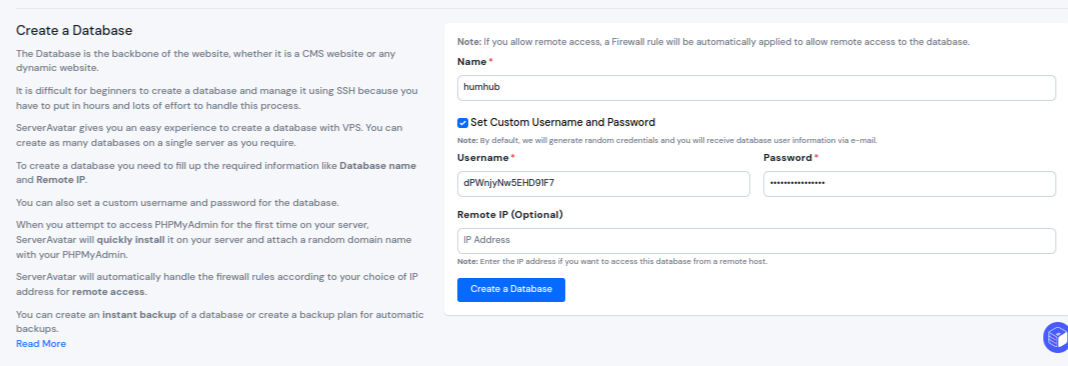
-
Note Down Database Details: Keep a record of the database name, username, and password for the next steps.
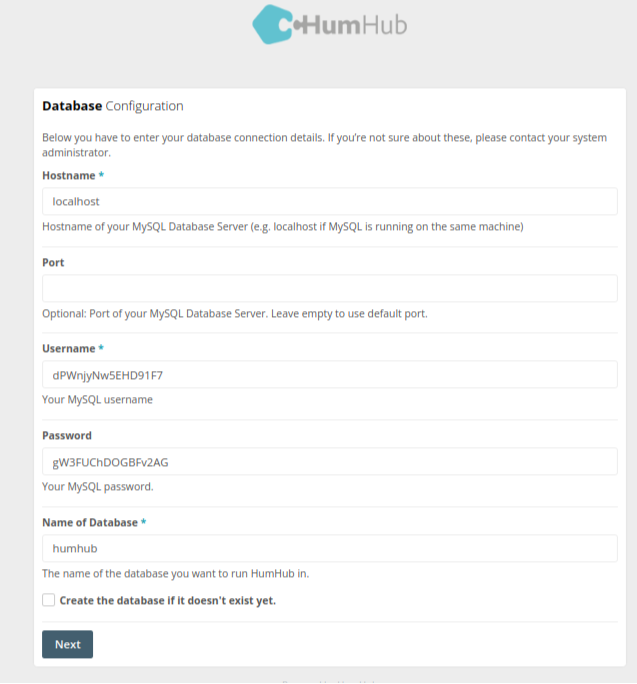
Step 5: Configure Scheduled Jobs (Cron Jobs)
Cron jobs are necessary for automating tasks within HumHub:
![]()
- Access Cron Jobs Section: Go to the cron jobs section in your server dashboard.
- Set Up Necessary Commands: Enter the commands required to schedule jobs for HumHub. This will ensure tasks such as email notifications and data cleanup are automated.
![]()
Step 6: Pretty URLs Configuration
To improve the readability and SEO-friendliness of your URLs, you need to configure pretty URLs:
![]()
-
Locate the common.php File: Use the file manager in your application dashboard to find common.php
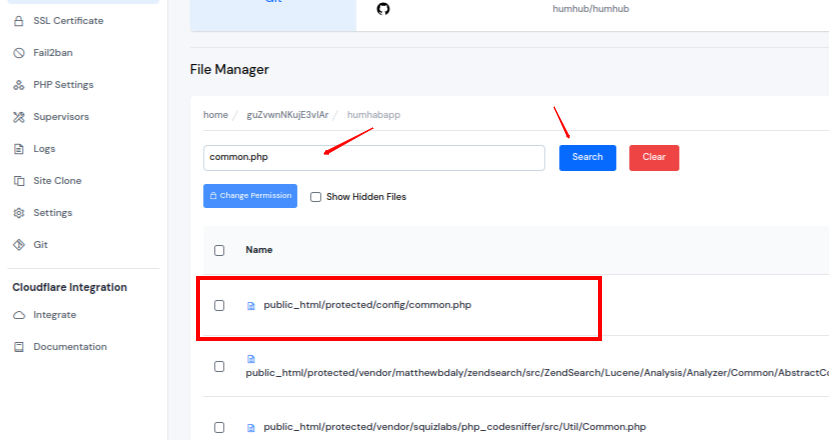
-
Edit the File: Add the necessary code to enable pretty URLs. The code will typically look something like this:
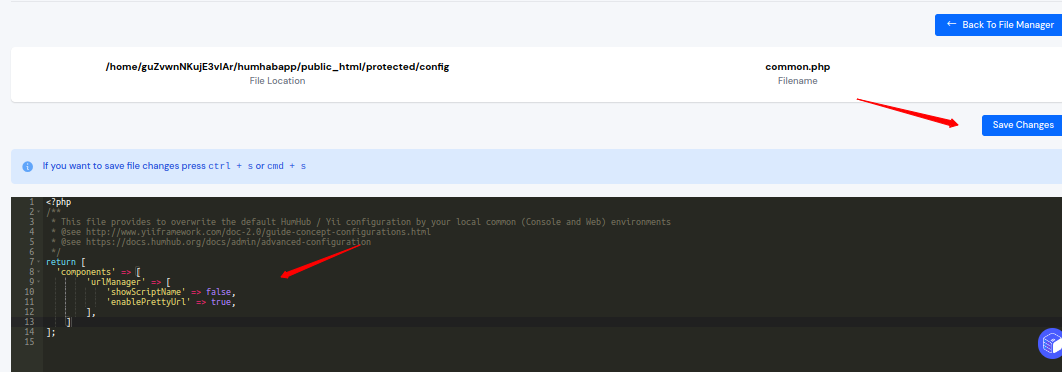
- Save Changes: After making the changes, save the file.
Step 7: Enter Social Network Name
During the installation, you will be prompted to enter the name of your social network:
- Enter Network Name: Choose a unique and relevant name for your social network.
- Proceed to Next Step: Click on the "Next" button to continue.
![]()
Step 8: Basic Configuration
Configure the basic settings of your HumHub installation:
- Select Configuration Options: Choose the options that best fit your needs.
- Click "Next": Move on to the next step by clicking the "Next" button.
![]()
Step 9: Security Settings
Security settings determine how new, unregistered users can access your HumHub instance:
- Configure Security Options: Decide on the level of security and access control for new users.
- Proceed: Click "Next" to continue.
![]()
Step 10: Recommended Modules
HumHub comes with a set of recommended modules that enhance functionality:
-
Review Recommended Modules: Look through the list of suggested modules.
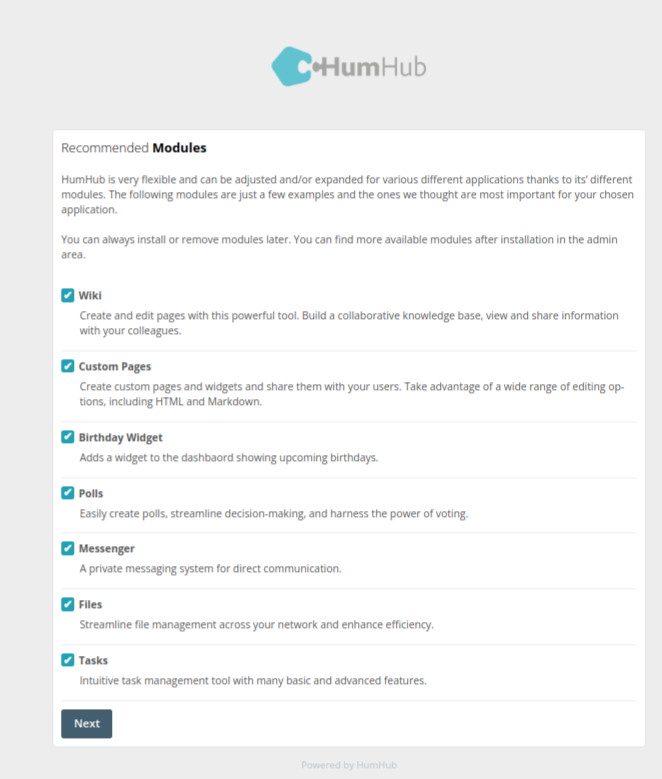
-
Install Modules: Choose which modules to install and click "Next" to proceed.

Step 11: Admin Account
Creating an admin account is crucial for managing your HumHub network:
- Fill Out the Form: Provide the necessary information to create an admin account.
-
Complete Account Creation: Submit the form to finalize the creation of your admin account.
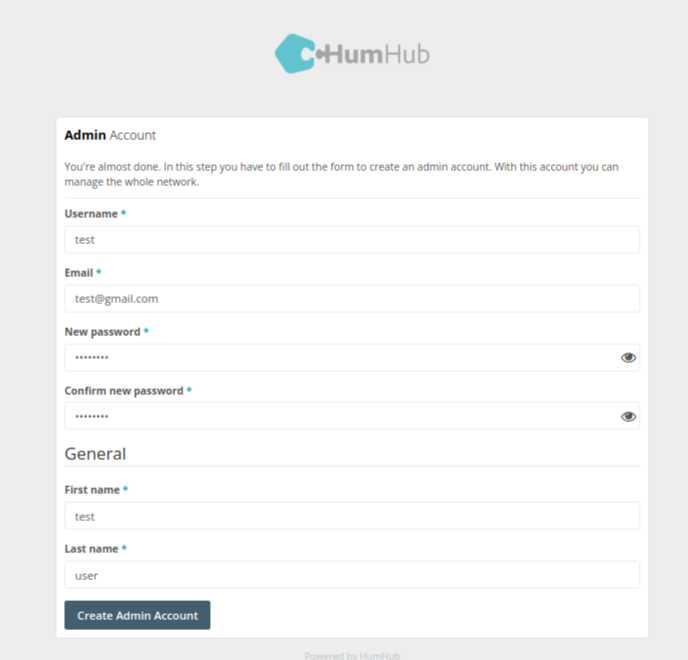
Step 12: Example Contents
To avoid a blank dashboard after your initial login, you can choose to install example contents:
- Install Example Contents: Opt to install sample content to see how your network will look with data.
-
Proceed to Next Step: Click "Next" to continue.
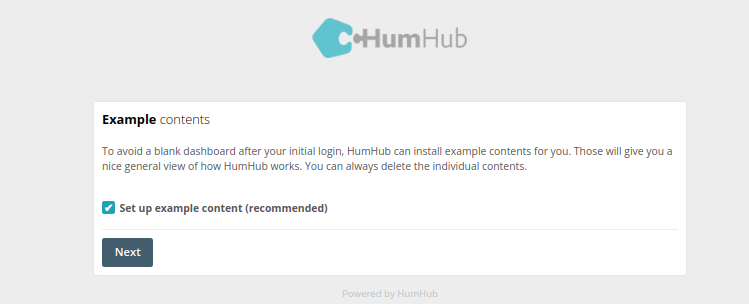
Step 13: Setup Complete
Once the installation is complete, you will see a confirmation screen:
-
Click on "Sign In": This will take you to the sign-in page.

Step 14: Sign In
Access your new HumHub instance:
- Enter Username and Password: Use the credentials you created for the admin account.
-
Sign In: Access your HumHub instance as an administrator.
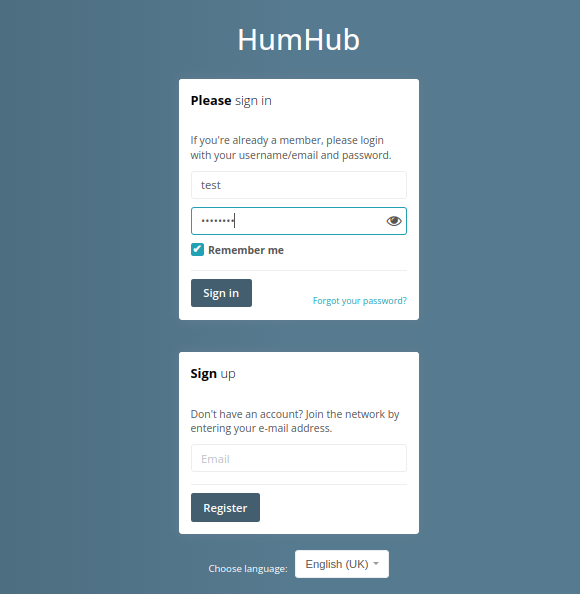
Step 15: Dashboard
After logging in, you will be taken to the HumHub dashboard:
- Configure Settings: Adjust the settings to suit your network's needs.
- Create User Roles: Define different user roles and permissions.
- Set Up Modules: Install and configure additional modules as needed.
![]()
By following these detailed steps, you can successfully set up HumHub and start building your community platform. For more detailed instructions and troubleshooting, refer to the HumHub Documentation.
Conclusion
HumHub is a powerful and flexible platform that can transform the way your organization communicates and collaborates. By leveraging its core components—Users, Spaces, Content, and Modules—you can build a robust and dynamic community tailored to your specific needs. Whether you’re looking to create a social network, knowledge base, or communication platform, HumHub provides the tools and features necessary to succeed. Start exploring HumHub today and discover how it can help you connect, share, and collaborate like never before.